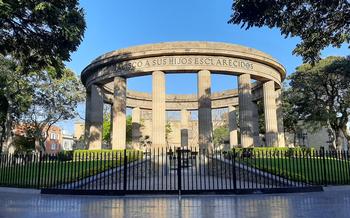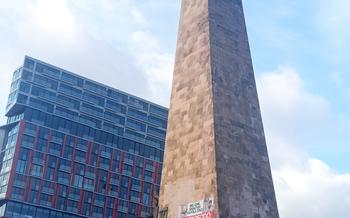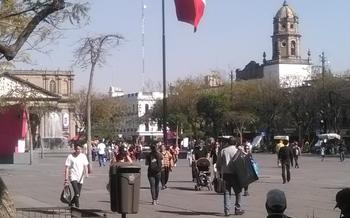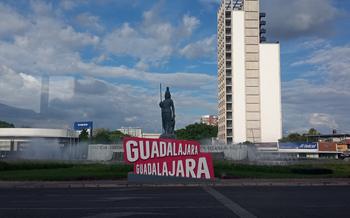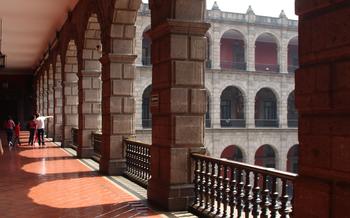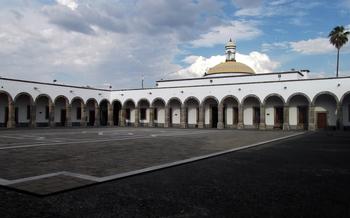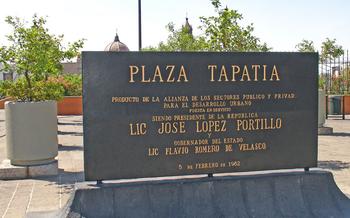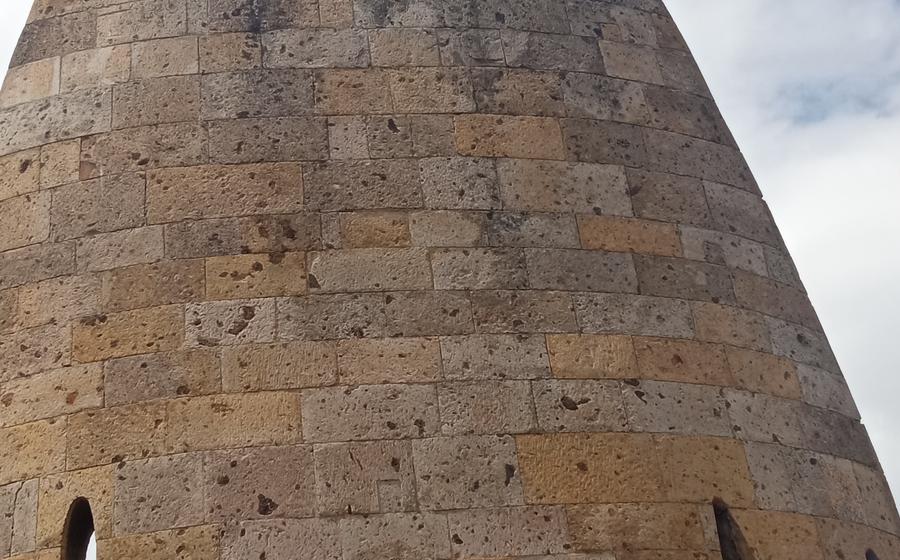
Plaza de la Bandera
- Plaza de la Bandera: A Symbol of National Pride
- Flag-Raising Ceremony: A Patriotic Spectacle
- The Monumental Flag: A Towering Symbol
- Museo de la Bandera: Delving into the History of the Mexican Flag
- Plaza de la Bandera's Gardens: A Tranquil Oasis
- National Anthem Performance: A Stirring Moment
- Changing of the Guard: A Display of Discipline
- Monument to the Niños Héroes: Honoring Young Heroes
- Plaza de la Bandera at Night: A Different Perspective
- Surrounding Attractions: Exploring the Area
- Photography Opportunities: Capturing the Essence
- Local Traditions and Folklore: Insights into Mexican Culture
- Interactive Displays: Engaging with History
- Accessibility for Visitors: Ensuring Inclusivity
- Insider Tip: Hidden Gems and Local Secrets
Plaza de la Bandera: A Symbol of National Pride
The Plaza de la Bandera stands as a majestic symbol of Mexican national pride and unity. Inaugurated in 1958, this iconic plaza is a tribute to the country's flag, representing its rich history, struggles, and triumphs. Located in the heart of Guadalajara, the Plaza de la Bandera is a must-visit attraction that captivates visitors with its architectural grandeur, cultural significance, and patriotic spirit.
Its strategic location along Avenida Vallarta makes it easily accessible by public transportation or private vehicles. The plaza's striking architectural features, including the towering flagpole and surrounding gardens, create a captivating visual spectacle that draws the attention of passersby and invites them to explore its symbolic depths.
Flag-Raising Ceremony: A Patriotic Spectacle
The Plaza de la Bandera comes alive every morning with a solemn and moving ceremony that pays homage to the Mexican flag. As the sun rises over the city, casting a warm glow on the plaza, a contingent of the Mexican military marches in with precision and discipline. The air fills with anticipation as the national anthem blares from loudspeakers, its stirring melody echoing through the vast expanse of the plaza.
The ceremony begins with a brief speech by a military official, emphasizing the significance of the flag as a symbol of national unity, pride, and sovereignty. The crowd stands in rapt attention, their gazes fixed on the monumental flag as it slowly unfurls, reaching its full height against the backdrop of the morning sky.
The sight of the towering flag, billowing in the breeze, evokes a sense of awe and reverence among the spectators. Many salute, their hands pressed against their hearts, as a gesture of respect and patriotism. The ceremony concludes with a resounding cheer, and the crowd disperses, carrying with them a renewed sense of national pride and belonging.
The Monumental Flag: A Towering Symbol
The Plaza de la Bandera is home to a truly remarkable sight: a monumental flag that stands tall, symbolizing the pride and unity of the Mexican people. Reaching an impressive height of 110 meters, this majestic flagpole is one of the tallest in the world. The flag itself is equally awe-inspiring, measuring 50 by 28 meters and weighing approximately 250 kilograms. It is a sight that fills onlookers with a sense of patriotism and national pride.
The monumental flag is not just a symbol; it is also a work of art. Designed by Mexican architect Pedro Ramírez Vázquez, the flagpole features a unique and innovative design that complements the surrounding landscape. The base of the flagpole is adorned with intricate carvings and sculptures that depict significant moments in Mexican history, adding to its cultural and artistic significance.
At night, the monumental flag transforms into an even more captivating sight. Illuminations bathe the flagpole and flag in a warm glow, creating a breathtaking spectacle that can be seen from afar. The flag flutters gently in the night breeze, a symbol of hope and resilience that stands watch over the city of Guadalajara.
Museo de la Bandera: Delving into the History of the Mexican Flag
Nestled within the premises of the Plaza de la Bandera, the Museo de la Bandera stands as a testament to the rich history and evolution of the Mexican flag. Through captivating exhibits and interactive displays, the museum invites visitors to embark on a journey of discovery, tracing the origins, symbolism, and cultural significance of this national emblem.
Upon entering the museum, visitors are greeted by an array of artifacts, documents, and interactive displays that showcase the different iterations of the Mexican flag throughout history. From the first flags used during the Mexican War of Independence to the present-day design, the museum provides a comprehensive overview of the flag's evolution.
Interactive experiences, such as multimedia presentations and virtual reality simulations, bring the history of the flag to life. Visitors can virtually experience key moments in Mexican history, such as the signing of the Plan of Iguala or the Battle of Puebla, gaining a deeper understanding of the role the flag played in shaping the nation's identity.
The museum also features a collection of flags from around the world, allowing visitors to compare and contrast the designs, colors, and symbolism of different nations. This comparative perspective highlights the uniqueness of the Mexican flag and its place within the global community.
Educational value is at the forefront of the Museo de la Bandera's mission. Through interactive exhibits, hands-on activities, and educational games, the museum engages visitors of all ages, fostering a sense of national pride and a deeper appreciation for Mexico's rich history and cultural heritage.
Plaza de la Bandera's Gardens: A Tranquil Oasis
Amidst the grandeur of the monumental flag and the patriotic ceremonies, Plaza de la Bandera offers a tranquil retreat in its beautifully landscaped gardens. Visitors can escape the hustle and bustle of the city and immerse themselves in nature's serenity.
The gardens are a testament to the meticulous planning and skillful execution of landscape architects. They feature a diverse array of plants and flowers, each carefully chosen to create a vibrant and harmonious tapestry. The vibrant colors and delicate fragrances of the blooms fill the air, creating a sensory feast for visitors.
Seating areas and relaxation spots are thoughtfully placed throughout the gardens, inviting visitors to pause, reflect, and soak in the tranquility of their surroundings. Whether seeking solace or simply enjoying a moment of respite, the gardens provide the perfect sanctuary.
The natural beauty and serenity of the gardens make them an ideal spot for a leisurely stroll, a picnic with loved ones, or a quiet moment of contemplation. Visitors can wander along the winding paths, marvel at the intricate flower arrangements, and let the gentle breeze caress their faces.
National Anthem Performance: A Stirring Moment
Every morning at 8:00 AM, the Plaza de la Bandera comes alive with a stirring rendition of the Mexican National Anthem. This solemn ceremony is a testament to the deep sense of patriotism and national pride that runs through the veins of every Mexican. As the first rays of sunlight illuminate the towering flag, the national anthem fills the air, creating a moment of unity and reverence among the gathered crowd. Spectators stand tall, their hands over their hearts, their voices joining in a chorus of pride and belonging. This daily ritual is not merely a display of patriotism; it is a reminder of the shared history, struggles, and triumphs that have shaped the Mexican nation.
Changing of the Guard: A Display of Discipline
The Plaza de la Bandera hosts a captivating Changing of the Guard ceremony, a spectacle that showcases the discipline and precision of the Mexican military. Every Sunday at 10:00 AM, the rhythmic sounds of marching boots echo through the plaza as the incoming guard marches in perfect synchrony, their uniforms crisp and their faces etched with determination. The outgoing guard stands at attention, their eyes fixed forward, as they prepare to hand over their duties.
The ceremony is a testament to the military's commitment to safeguarding the national flag and the country it represents. The soldiers, adorned in their ceremonial uniforms, execute intricate maneuvers with flawless coordination, their movements a testament to their rigorous training. The precision of their steps and the sharpness of their salutes evoke a sense of awe and admiration among the spectators.
The Changing of the Guard ceremony is not merely a symbolic display but also an opportunity for the public to engage with the military and witness firsthand their unwavering dedication to their nation. The soldiers' impeccable discipline and unwavering commitment serve as a reminder of the importance of patriotism and national pride.
Monument to the Niños Héroes: Honoring Young Heroes
The Plaza de la Bandera pays homage to the heroic children of Mexico, known as the Niños Héroes, who fought valiantly against the invading American forces during the Battle of Chapultepec in 184A poignant monument stands in their honor, commemorating their selfless sacrifice and indomitable spirit.
The monument, designed by renowned sculptor Ernesto Tamariz, depicts six young cadets, frozen in a moment of defiance, defending their country against overwhelming odds. Their youthful faces, etched with determination and resolve, evoke a profound sense of admiration and respect.
The monument serves as a constant reminder of the bravery and patriotism of these young heroes, whose sacrifice continues to inspire generations of Mexicans. It is a powerful symbol of the nation's resilience and the unwavering commitment to defend its sovereignty.
Educational plaques surrounding the monument provide visitors with a deeper understanding of the historical context and the significance of the Niños Héroes' actions. Their heroic deeds are a testament to the indomitable spirit of youth and the enduring power of courage in the face of adversity.
Plaza de la Bandera at Night: A Different Perspective
As the sun sets and darkness envelops the city, the Plaza de la Bandera transforms into a mesmerizing spectacle of lights and colors. The towering flagpole, adorned with intricate illuminations, becomes the epicenter of a captivating light show, casting a radiant glow across the plaza. The surrounding gardens, bathed in soft hues, exude an ethereal ambiance, inviting visitors to immerse themselves in the tranquil beauty of the night.
During the evening hours, the plaza often hosts cultural events and activities, adding to its vibrant atmosphere. From live music performances to traditional dance shows, these events showcase the rich cultural heritage of Mexico and provide visitors with a unique and immersive experience. The plaza's lively atmosphere and stunning visuals make it a popular destination for both locals and tourists alike, offering a glimpse into the city's vibrant nightlife.
However, it's important to note that while the plaza is generally safe at night, visitors should exercise caution and be aware of their surroundings, as with any urban area. Taking necessary safety precautions, such as avoiding isolated areas and being mindful of personal belongings, will ensure a pleasant and enjoyable experience.
Surrounding Attractions: Exploring the Area
Beyond the Plaza de la Bandera itself, the surrounding area offers a wealth of attractions to further enrich your visit. History buffs can delve into the past at the nearby Regional Museum of Guadalajara, showcasing pre-Columbian artifacts and colonial-era treasures. The Hospicio Cabañas, a UNESCO World Heritage Site, is a former orphanage adorned with stunning murals by renowned Mexican artist José Clemente Orozco.
For those seeking a shopping haven, the Plaza del Sol shopping mall is a short distance away, offering a myriad of retail options, from international brands to local boutiques. Art enthusiasts can visit the nearby Instituto Cultural Cabañas, which houses temporary exhibitions and a permanent collection of Mexican and international art.
After a day of exploration, satisfy your taste buds with Guadalajara's culinary offerings. The surrounding area boasts a diverse range of restaurants, from traditional Mexican cuisine to international flavors. Indulge in the city's signature dish, birria, a slow-cooked meat stew, or savor the flavors of pozole, a hearty soup made with hominy and pork or chicken.
Photography Opportunities: Capturing the Essence
The Plaza de la Bandera offers a wealth of opportunities for photography enthusiasts to capture the essence of this iconic landmark. The towering flag monument, with its vibrant colors and intricate design, provides a striking subject for photographs. Visitors can experiment with different angles and perspectives to create unique and eye-catching shots.
The best time to capture the monument in its full glory is during the golden hours of sunrise and sunset, when the warm light casts a magical glow on the plaza. Photographers can also take advantage of the contrast between the monument's bright colors and the deep blue sky during the day.
To capture the best shots, photographers should consider using a tripod to ensure stability and avoid camera shake. Experimenting with different shutter speeds can create interesting effects, such as blurring the movement of the flag or capturing the ripples in the water features.
Once you have captured your perfect shots, don't forget to share them on social media to inspire others to visit this incredible landmark. Use hashtags like #PlazadelaBandera, #Guadalajara, and #Mexico to connect with fellow travelers and photography enthusiasts.
Local Traditions and Folklore: Insights into Mexican Culture
The Plaza de la Bandera is not merely a physical space but also a cultural hub where Mexican traditions and folklore intertwine. The plaza has become a canvas for legends and stories that have been passed down through generations, embodying the rich tapestry of Mexican heritage. One of the most prominent tales associated with the plaza is the story of the "Niños Héroes," six young cadets who bravely defended Chapultepec Castle during the Mexican-American War. Their heroic sacrifice is commemorated by the monument that stands in the plaza, serving as a poignant reminder of the nation's resilience and unwavering spirit.
The plaza is also a stage for traditional celebrations and events that showcase the vibrant Mexican culture. During the annual Independence Day festivities, the plaza transforms into a sea of green, white, and red as locals gather to celebrate the country's freedom. The air fills with the sounds of mariachi music, traditional dances, and joyous laughter, creating an atmosphere of unity and national pride. These events offer visitors a glimpse into the heart of Mexican culture and provide an opportunity to immerse themselves in the country's rich traditions.
Interactive Displays: Engaging with History
The Plaza de la Bandera takes visitor engagement to the next level with a range of interactive displays that bring the history and significance of the Mexican flag to life. Multimedia presentations and virtual reality experiences immerse visitors in the stories and events that have shaped the nation's identity. Interactive exhibits and hands-on activities invite visitors to explore the flag's symbolism and its role in Mexican culture. Educational games and quizzes provide a fun and interactive way to learn about the history and significance of the Mexican flag. These interactive elements enhance the visitor experience, making the Plaza de la Bandera not just a place to admire the monumental flag but also a place to engage with history and gain a deeper understanding of Mexican culture.
Accessibility for Visitors: Ensuring Inclusivity
The Plaza de la Bandera is committed to providing an inclusive and accessible experience for all visitors. Wheelchair-accessible ramps and designated parking spaces ensure that visitors with mobility challenges can navigate the plaza with ease. Braille signage and audio guides are available for the visually impaired, enabling them to fully appreciate the history and significance of the site. Information is provided in multiple languages, catering to visitors from diverse backgrounds. The plaza also offers accommodations for visitors with disabilities, such as reserved seating during ceremonies and accessible restrooms. With these thoughtful provisions, the Plaza de la Bandera strives to create a welcoming and inclusive environment where everyone can learn about and celebrate the history of the Mexican flag.
Insider Tip: Hidden Gems and Local Secrets
For a truly immersive experience, step off the beaten path and explore the hidden gems that surround the Plaza de la Bandera. Visit the Mercado Libertad, a bustling traditional market where you can find an array of local products, from colorful handicrafts to mouthwatering street food. For a taste of history, uncover the secrets of the Templo de San Juan de Dios, a 16th-century church with stunning colonial architecture and a rich past. Engage with the locals at the Plaza Tapatía, where you can witness traditional dances, listen to live music, and savor delicious local cuisine. By venturing beyond the main attractions, you'll gain a deeper appreciation for Guadalajara's vibrant culture and warm hospitality.
